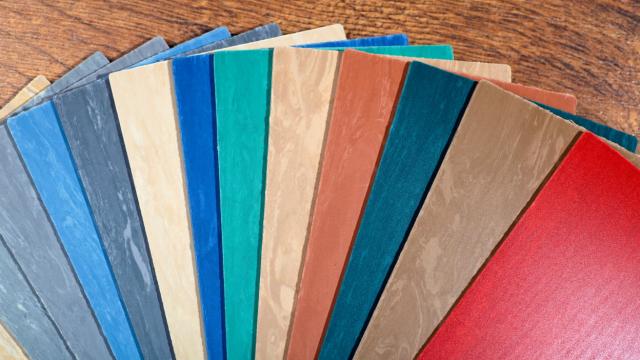Let’s say you recently moved into a new home, and want to deep-clean and then properly maintain your kitchen floors. That should be a relatively straightforward task, but unfortunately, you aren’t entirely sure whether they’re vinyl or linoleum. The good news is that there are a few simple ways you can make that distinction so you can care for the flooring in the best possible way.
The difference between vinyl and linoleum floors
First, let’s talk about the difference between vinyl and linoleum floors. According to Joe Ferguson, an architectural joiner at Skirtings R Us, traditional linoleum is made from natural, eco-friendly materials, while vinyl which is typically made from polyvinyl chloride (PVC)—a durable plastic. “Compared to linoleum, vinyl is often easier to use for DIY projects, and can be removed piece by piece,” he says. “Although available in tiles or planks, linoleum is often laid out by sheet.”
How to figure out whether you have vinyl or linoleum floors
Keeping those differences in mind, here are a few tips for determining whether your floor is vinyl or linoleum, courtesy of John Peña, a real estate agent and the CEO of Peña El Paso Realty Group and Keith Sant, founder and CEO of Kind House Buyers:
Look at the material
For Peña, one of the easiest ways to determine whether the flooring is vinyl or linoleum is by looking at the texture and pattern of the material. “Vinyl flooring usually has a printed pattern that mimics the appearance of natural materials like wood or stone, while linoleum has a more uniform and consistent pattern,” he says. “Also, vinyl flooring often has a glossy finish while linoleum tends to have more of a matte finish.”
Check for trademarks or labels
Sant suggests looking for trademark signs or logos on the flooring itself: “These can often be found hidden in corners, or along the edges of the floorboards, and can provide valuable information about the type of material used in your flooring.”
Along with trademarks, logos, and labels, Peña also recommends looking for serial numbers or other codes that may identify the type of material on the backside of the flooring.
Test the flexibility
Another way to determine the type of flooring is by doing a simple test (in an inconspicuous spot). “For example, vinyl flooring tends to be more flexible and can be easily dented or scratched with a sharp object,” Sant says. “On the other hand, linoleum is more durable and resistant to scratches and dents.”
Why identifying your flooring type matters
Why go through this hassle? First, knowing whether your floors are vinyl or linoleum will allow you to properly care for them. “Vinyl and linoleum require different cleaning methods and products, so knowing which one you have will help prevent damage to the material,” Peña says.
It will also give you a better idea of how long you can expect the flooring to last. “While both types of flooring are durable, linoleum tends to have a longer lifespan and can withstand more wear and tear compared to vinyl,” Sant says.
Finally, this knowledge could come in handy if your floor gets damaged and you want to replace some or all of it. “Knowing the type can help with selecting the right materials and tools needed for the job,” Sant says.

Leave a Reply
You must be logged in to post a comment.